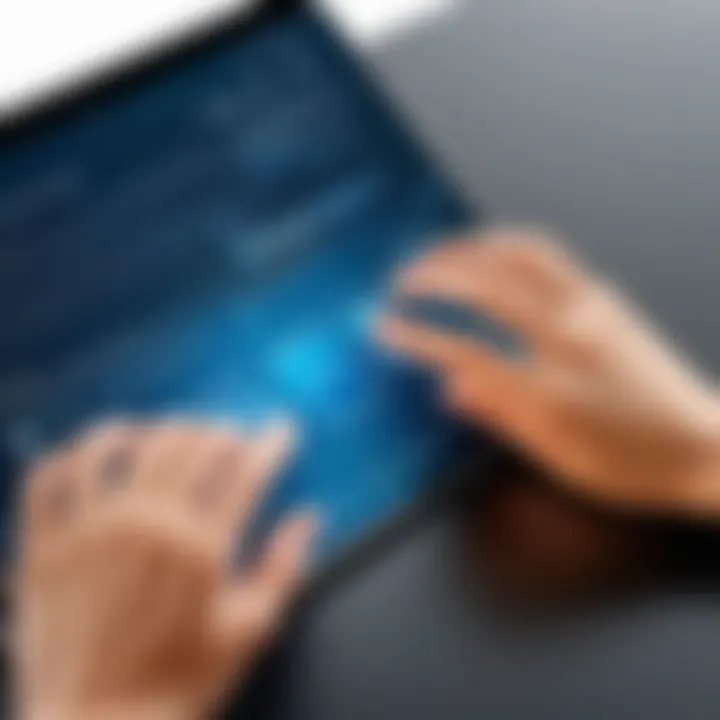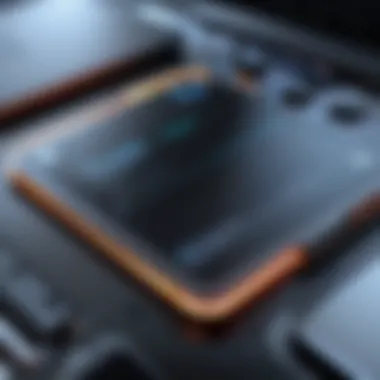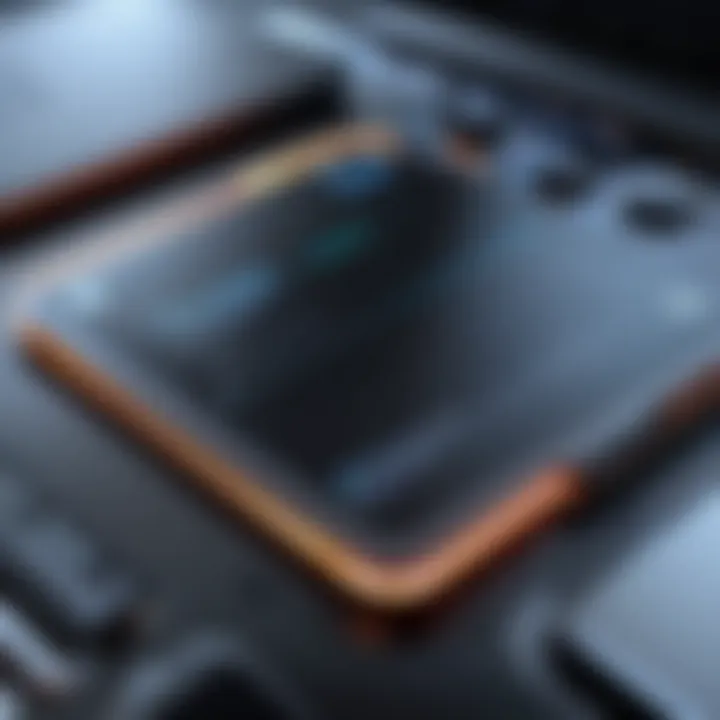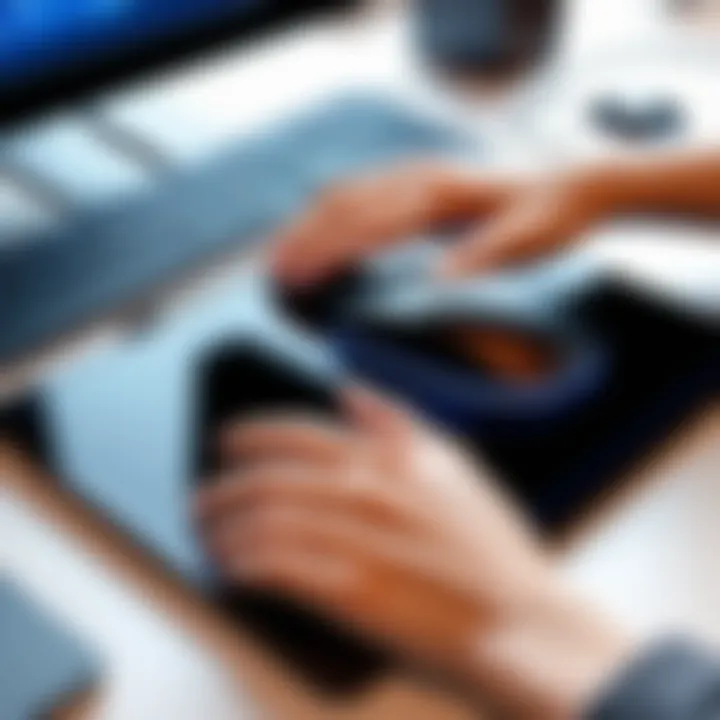Fixing Touchpad Problems: A Complete Guide for Techies


Intro
Touchpads have become a staple for many users, intertwined in our daily tech experiences. These little panels, so integral for navigation, sometimes misbehave, sputtering out frustrations for both casual users and seasoned IT professionals. The focus here is not merely on the annoyance of a non-functional touchpad but on a structured approach to identify, diagnose, and resolve the underlying issues. With gadget dependency rising, especially for remote work or online schooling, understanding the intricacies of touchpad functionality is paramount. This guide serves to arm you with troubleshooting techniques, practical steps, and a solid framework to tackle any touchpad challenge that comes your way.
Overview of Hardware/Software
Understanding Touchpad Technology
Touchpads, embedded typically in laptops, use capacitive technology to detect motion and touches. This means they sense your fingers' electrical properties, translating movements into cursor actions on your screen.
Key Features
- Multi-touch Support: Most modern touchpads recognize gestures like pinch to zoom or swiping between applications.
- Precision Control: Enhanced firmware enables sharper tracking for users, particularly in graphic design or gaming contexts.
- Customizable Settings: Software often allows users to tweak sensitivity, button configurations, and even disable the pad during typing to avoid those annoying unintentional taps.
Specifications and Technical Details
A touchpad's functionality hinges on a seamless interplay of hardware and software components. Typical specs include:
- Size: Ranges from 3 to 5 inches diagonally, influencing ease of navigation.
- Resolution: Measured in DPI (dots per inch), higher DPI offers improved accuracy.
- Driver Software: Crucial for translating gestures and clicks into system commands.
This interplay can lead to a host of issues should either hardware or software fail.
Pricing and Availability
Touchpads are usually included when purchasing a laptop, but external touchpads are also an option for those who favor a specific feel. Prices typically vary from $15 for basic models to over $100 for high-end, precision touchpads from brands like Wacom or Apple.
Comparisons with Previous Models
Advancements in touchpad technology have been notable over the years. For example, earlier models often limited gestures to basic tapping. Now, even entry-level devices often support complex multi-finger gestures.
Pros and Cons
Highlighting Strengths and Weaknesses
Pros:
- Convenience: Touchpads offer seamless navigation without needing an external mouse.
- Compact Design: Perfect for on-the-go usage; no additional peripherals to carry.
- Gesture Support: Offers a range of useful setups like three-finger swiping to switch apps.
Cons:
- Accidental Clicks: Users may hit the pad while typing, leading to unwanted activities.
- Finger Sensitivity Variance: Some might find the touchpad too sensitive or not sensitive enough.
User Feedback and Reviews
While many users praise the convenience of built-in touchpads, various complaints arise regarding their sensitivity and accuracy, often leading to a demand for alternative input methods like external mice. On platforms like Reddit, discussions about various models reveal a spectrum of user experiences, helping to shape perceptions about what to consider when choosing a device.
Performance and User Experience
Performance Testing Results
Touchpad performance can be gauged by its responsiveness and precision. For instance, models with a higher DPI perform significantly better with gestures in design software compared to lower-end counterparts.
User Interface and Ease of Use
Most users find touchpads intuitive, although customization options can be somewhat buried within settings menus, potentially vexing less tech-savvy individuals.
Real-World Usage Scenarios
Consider a graphic designer relying on touchpad precision for detailed work. The touchpad's DPI and responsiveness can critically affect their workflow efficiency. In contrast, a student multitasking between notes and research will prioritize straightforward navigation ease.
Efficiency and Productivity Impact
When working optimally, a well-functioning touchpad can enhance productivity considerably. Swift navigation across screens without the hiccup of an active hand or misinterpretation of gestures streamlines tasks dramatically.
Innovation and Trends
Industry Trends Related to Touchpad Technology
As touchpads evolve, trends show a significant move towards tactile feedback and enhanced gesture detection. Some models are even integrating artificial intelligence to learn user preferences over time.
Innovative Features and Functionalities
Recent innovations include touchpads with pressure sensitivity, enabling varying responses based on how hard one presses, similar to stylus features in tablets.
Potential Impact on the IT Industry
With the rise of remote work, superior touchpad technology could play a pivotal role in user experience and productivity. IT departments are likely to focus on ensuring touchpad functionality across devices to maintain efficiency in the workplace.
Recommendations and Epilogue
Overall Verdict and Recommendations
Touchpads, while convenient, can become a source of significant headaches if issues arise. Regular maintenance, including driver updates and settings checks, can preempt many common problems.
Target Audience Suitability
This guide is tailored for IT professionals and tech aficionados who wish to deepen their understanding of touchpad mechanics. Insights offered here could assist in training others or troubleshooting in diverse environments.
Final Thoughts and Future Prospects
In a world increasingly reliant on technology, ensuring our tools – like touchpads – operate smoothly is integral. By understanding potential issues and their resolutions, users enhance their capabilities, paving the way for a more efficient technological experience.
Intro
In today's fast-paced digital world, a touchpad that fails to function properly can throw a wrench in anyone's daily routine, especially for IT professionals and tech enthusiasts. Touchpads have become the lifeline of portable devices, providing a seamless method to navigate and interact with technology without the need for an external mouse. When these devices malfunction, it not only hampers productivity but can also be frustrating for users who rely heavily on them.
Understanding the challenges that can arise with touchpad functionality is critical. Many users find themselves scratching their heads, trying to pinpoint the problem. Is it a software glitch, a driver issue, or a hardware malfunction? The troubleshooting journey can feel overwhelming, yet knowing how to approach these common problems can significantly ease the path to resolution.


This article aims to empower readers by equipping them with thorough strategies and troubleshooting techniques. We will take a closer look at:
- Touchpad Components and Functionality: Knowing what's under the hood helps when things go awry.
- Common Causes for Failures: Identifying patterns of issues may save time.
- Step-by-Step Troubleshooting: A systematic approach will lead to a quicker solution.
- Configuration and Driver Details: Settings may hold the key to functionality.
- User-Specific Scenarios: Understanding each unique case is crucial to finding the right fix.
By addressing touchpad complications in a methodical manner, we not only build technical expertise but also enhance problem-solving capabilities. Each section will unravel practical steps and considerations, allowing readers to navigate touchpad issues with confidence.
"A problem well stated is a problem half-solved."
With this guide, you will be guided through a structured approach to tackle touchpad failures, transforming technical stumbles into manageable challenges. The importance of maintaining functionality with touchpads cannot be understated—efficiency in work and everyday tasks hinges on this simple yet complex component of our devices. Let's delve deeper into the intricacies of touchpad functionality and unveil the common causes that may disrupt it.
Understanding Touchpad Functionality
Understanding touchpad functionality is at the heart of diagnosing and resolving touchpad-related issues. A touchpad serves as the primary interface for navigation on many laptops, allowing users to move the cursor, select items, and perform gestures without the need for an external mouse. Therefore, maintaining its functionality is essential for a seamless computing experience.
When one delves into the workings of a touchpad, one realizes that it is more than just a flat surface; it integrates complex technology that translates physical touch into digital command. This knowledge empowers IT professionals and tech enthusiasts to not only troubleshoot but also optimize the touchpad for enhanced user experience.
Key elements of understanding touchpad functionality include:
- User Interaction: Knowing how users physically interact with the touchpad aids in troubleshooting. For example, different fingers or gestures might affect responsiveness.
- Technological Components: Familiarity with the internal parts, like sensors and circuit boards, can illuminate potential failure points.
- Software Dependencies: Recognizing how the operating system and drivers affect touchpad performance allows for a clearer pathway to solutions.
Grasping these points gives one the edge when addressing issues. Moreover, comprehending the touchpad’s layout—whether it's multi-touch capable or basic—can significantly change troubleshooting approaches. With technology advancing rapidly, touchpad features also evolve. Thus, staying abreast of the latest trends becomes a crucial part of effectively resolving touchpad challenges.
Components of a Touchpad
A touchpad comprises several critical components that work together to facilitate gesture recognition and cursor movement. Understanding these elements can provide insight into why a touchpad may malfunction. Here are the main components:
- Capacitive Sensors: These sensors detect the electric field changes caused by a finger touching the pad. They form the backbone of the touchpad's functionality.
- Microcontroller: This acts as the brain of the touchpad, processing input signals from the sensors and interpreting them for the operating system.
- Circuit Board: The physical layout that connects all components together, enabling communication between the sensors and the software.
- Surface Material: The type of material used (e.g., plastic vs. glass) can influence touch sensitivity and durability.
- Firmware: This software is embedded in the hardware that controls touchpad functions and responds to user commands.
Having a clear understanding of these components not only makes fault-finding easier but also aids in communicating issues more effectively with technical support.
Common Causes of Touchpad Failures
Several factors can lead to touchpad failures, many of which may catch users by surprise. Addressing these factors requires a systematic examination:
- Driver Issues: Outdated or corrupted drivers often lead to poor touchpad performance. Installing the latest drivers can rectify many problems.
- Hardware Connection Problems: Loose connections between the touchpad and the motherboard can lead to intermittent failures.
- Water Damage: Liquid spills on the touchpad can cause it to malfunction or stop working entirely.
- Wear and Tear: Physical degradation over time can lead to inconsistencies in touch sensitivity or complete failure.
- Software Conflicts: Occasionally, new installations or updates can conflict with touchpad drivers, leading to operational lapses.
By grasping these common pitfalls, users can tackle touchpad issues methodically and efficiently. Each point addressed lays a foundation for understanding the troubleshooting steps that follow in this guide.
Initial Troubleshooting Steps
In the realm of touchpad troubles, the initial troubleshooting steps act as the cornerstone for an effective resolution. This phase may seem straightforward, but don't be fooled; it plays a critical role in isolating the root cause of the issue. By methodically following these steps, users can save time, reduce frustration, and ensure that they aren't overlooking simple, yet often key, fixes. This logical approach sets the stage for more advanced diagnostics, which may require greater technical expertise.
Basic Checks and Rebooting
Before diving into complex solutions, the commonsensical approach often yields substantial results. Start with basic checks. Ensure that the touchpad is properly enabled. Sometimes, it’s just a matter of a misplaced touchpad toggle, hidden among the myriad of function keys or tucked away in the settings menu. Verifying the connection of any external devices is also a prudent step.
Next, rebooting can cure a multitude of computing ills. It clears out the temporary glitches that might be bogging down the touchpad’s functionality. By offering the system a fresh start, users can often resolve problems that may otherwise seem intractable. Even a quick restart can make a world of difference.
Remember: If the issue persists after basic checks and rebooting, proceed to more intricate assessments.
Verifying Functionality in BIOS
One of the less glamorous, yet crucial steps in diagnosing touchpad issues is entering the system's BIOS. This can often feel like venturing into uncharted territory, but fear not! The BIOS acts as a bridge between hardware and software, providing invaluable insights into your device's functionality. When you boot up the computer, you can access the BIOS, typically by pressing a designated key, such as Esc, Del, F2, or F12, often displayed on your screen during startup.
Inside the BIOS settings, navigate to the peripherals or device settings. From there, you can confirm whether the touchpad is recognized by the system. If it’s disabled in BIOS, then that’s a straightforward fix, enabling you to breathe life back into your touchpad.
Moreover, conducting this check verifies that hardware components are adequately communicating with the system, which is fundamental in preventing further complications.
Remember, this troubleshooting step, albeit on the more technical side, should not be overlooked. Ensuring that the touchpad is active at the BIOS level confirms the hardware's presence and sets a strong foundation for resolving any operational hiccups.
Configuration Issues
In the realm of touchpad functionality, configuration issues often stand as the invisible barrier, preventing users from enjoying a smooth interaction with their devices. Understanding how these settings influence touchpad performance is crucial for users who rely on precision and responsiveness in their computing tasks. Misconfigurations can lead to unresponsiveness, erratic behavior, or even complete failure of the touchpad. Consequently, taking the time to delve into configurations isn’t merely a recommended step; it's imperative for maintaining a seamless computing experience.
Examining Touchpad Settings in OS
A first port of call when diagnosing touchpad troubles is examining the touchpad settings within your operating system. Each OS provides a unique interface for managing this hardware, and navigating it correctly can be a game changer. For instance, in Windows, users can access these settings through the Control Panel or Settings menu. Going deeper, you might find options labeled as "Touchpad," "Mouse," or even the specific software bundled with the touchpad's manufacturer, like Synaptics or ELAN.
In these settings, users can adjust various parameters, such as palm rejection, scrolling behavior, and gestures. Ensuring these features are appropriately configured can prevent accidental clicks. For example, if your pointer appears to jump around randomly while typing, it may simply indicate that palm rejection is turned off or set too lenient.
When tweaking configurations, it’s wise to note what changes you make. This habit allows you to revert back to original settings if something doesn't quite feel right later.
Adjusting Touchpad Sensitivity and Features
Sensitivity settings can be a double-edged sword. On one hand, a highly sensitive touchpad can enhance productivity, reducing the effort needed for minor movements. On the other hand, if set too high, it can lead to frustration when every accidental brush registers a click.
Here are some factors to consider when adjusting sensitivity:
- Sliding Speed: This determines how fast the cursor moves with your finger movement. Finding the right speed can balance control and efficiency.
- Tap Sensitivity: It usually has two settings: a light tap and a more deliberate one. Adjust this setting to align with your typing style for minimal interruptions.
- Gestures: Advanced touchpads often include gesture controls. Making sure these features are both enabled and properly configured can empower your workflow. Common gestures include pinching to zoom, two-finger scrolling, and three-finger swipe.
Keep in mind that with each software update, settings may reset or new features may become available, so periodic checks could save a lot of hassle later. For anyone unsure of changes, it’s always a good idea to defer to the touchpad’s user manual or manufacturer's website for guidance. Additionally, engaging with community forums on resources like reddit.com can provide practical insights from users who have faced similar issues.
"Touchpad adjustments are often overlooked but can significantly enhance user experience. Exploring settings ensures you’re not just using a device; you’re mastering it."
Taking the time to thoroughly investigate and adjust these configuration settings can vastly improve your touchpad experience. So, whether it's through ensuring that the correct driver is installed or customizing sensitivity to suit your preference, these steps are fundamental in solving potential touchpad problems.
Driver Reinstallation
When it comes to addressing touchpad issues, the importance of driver reinstallation cannot be overstated. Drivers act as the bridge between the operating system and the touchpad hardware, enabling them to communicate effectively. If these drivers are outdated, corrupted, or incompatible, the touchpad may become unresponsive or malfunction entirely. A fresh installation of the driver often resolves a multitude of problems, restoring functionality and enhancing overall performance.
Considering that issues can arise from various sources such as software conflicts or erroneous updates, knowing how to reinstall touchpad drivers gives you a viable route for troubleshooting. This step should be a go-to solution for anyone facing persistent touchpad troubles, as it often brings quick relief and renews device functionality.
Identifying the Current Driver
Before you venture into reinstalling drivers, the first task is pinpointing the current driver your device uses. This knowledge is key for ensuring you download the right files. Here’s how you can go about it:
- Open Device Manager: Right-click the Start button and select Device Manager from the list. This gives you a comprehensive view of all the connected devices.
- Find the Touchpad Section: Expand the "Mice and other pointing devices" section. Under this section, you should find the touchpad listed, often referred to by its manufacturer, like Synaptics or ELAN.
- Check Driver Properties: Right-click on your touchpad entry and choose Properties. Navigate to the Driver tab, where you will find valuable information such as the driver version and the date it was last updated.


Arming yourself with this information sets a solid foundation for the next steps.
Steps for Updating Touchpad Drivers
Updating touchpad drivers isn’t as daunting as it may seem. Following a straightforward process can lead to significant improvements in responsiveness and functionality. Here’s a step-by-step guide to help you through:
- Navigate to Device Manager: Follow the steps mentioned earlier to open Device Manager.
- Locate Your Touchpad: Expand the relevant section to find your touchpad driver.
- Update Driver: Right-click on the touchpad driver and select Update Driver. You’ll be prompted with two options:
- Follow the Prompts: If you select the automatic search, the process will run, and if an update is found, it will download automatically. If you browsed manually, locate the downloaded driver file and select it for installation.
- Restart Your Computer: It’s often best to restart your system after updates to ensure changes take effect properly.
- Search automatically for updated driver software: This option will search your computer and the internet for the most recent touchpad driver.
- Browse my computer for driver software: Choose this if you’ve already downloaded the latest driver from the manufacturer’s site.
Updating drivers keeps your system running smoother and ensures compatibility with the latest OS features. If you still run into issues even after updating, it might be time to dig deeper into driver reinstallation or alternative troubleshooting methods.
Hardware Investigations
Understanding hardware components is crucial when attempting to resolve touchpad issues. Often, the failure of a touchpad can be traced back to a physical disconnection or damage. Direct examination of hardware can reveal underlying problems that settings or software updates cannot address. By delving into hardware investigations, tech enthusiasts and IT professionals can pinpoint the exact cause of touchpad failures, leading to quicker and more effective resolutions.
Examine Hardware Connections
The first step in any hardware investigation involves examining the connections associated with the touchpad. Loose or disconnected cables can prevent the touchpad from functioning correctly. If the touchpad is not responding, the connections need checking. Follow these steps:
- Power Down: Always start by shutting down the device completely to avoid any electrical issues.
- Remove Back Cover: Using the appropriate tools, remove any screws and gently take off the back cover of the laptop. This process may differ across models.
- Check for Loose Cables: Look for the touchpad connector. Ensure that all cables are secure, with no obvious signs of wear.
- Reconnect if Necessary: Gently reseat any loose connections, and ensure that connectors are aligned properly.
- Test the Touchpad Again: Once everything appears secure, replace the back cover and power on the device to check if the touchpad is functioning.
Taking the time to examine hardware connections not only saves time but also minimizes the risk of unnecessary software troubleshooting.
Testing the Touchpad with External Devices
Sometimes, the issue isn’t solely with the touchpad itself but rather with the system's ability to recognize input devices. Testing with external devices can offer clues about the underlying cause. Connect an external USB mouse to the laptop. If the external mouse works, but the touchpad doesn’t, it may provide insights:
- Touchpad Disabled: Check for a lock function on the keyboard that disables touchpad functionality.
- Driver Conflict: Sometimes, the driver for the external mouse can conflict with the touchpad. Updating or reinstalling drivers may be needed.
- System Preferences: Verify if the operating system is set to disable the touchpad when an external mouse is connected.
Testing with an external mouse can help determine whether the problem stems from the touchpad itself or if other settings or drivers need attention. It broadens the scope of investigation and often leads to quicker troubleshooting.
Visual Inspection for Physical Damage
Visibly inspecting the touchpad can unveil a variety of issues that may not be evident from software diagnostics alone. Physical damage like cracks, scratches, or dents can directly affect the touchpad's ability to function. Here's how to conduct a thorough visual inspection:
- Look for Surface Damage: Examine the surface. Are there any cracks? Any visible wear or dirt that might inhibit function?
- Check the Edges: Look around the edges for signs of detachment or misalignment. This can indicate greater issues that require fixing.
- Inspect for Foreign Objects: Sometimes, debris can get lodged under the touchpad, affecting its performance. Cleaning underneath the touchpad can sometimes solve the problem.
- Functional Testing: After visual inspection, test the responsiveness of the touchpad. Observe if there’s lag or failure to register inputs.
A meticulous visual inspection can lead to identifying problems that are hidden from common troubleshooting techniques. By focusing on hardware aspects and combining this with previously discussed methods, you equip yourself with a comprehensive understanding to tackle touchpad issues.
Operating System Compatibility
In today's tech landscape, ensuring compatibility between hardware components like touchpads and the operating systems (OS) is crucial for maintaining smooth functionality. When a touchpad malfunctions, one of the first areas to investigate is whether it aligns with the current OS. Incompatibilities can arise from various situations such as outdated drivers, mismatched software requirements, or even a lack of support for certain touchpad features.
Operating system compatibility not only affects performance but could also potentially impact overall user experience. If a specific feature of the touchpad is unsupported by the OS, it might lead to unexpected behaviors, reduced responsiveness, or total inoperability. Therefore, an informed understanding of how the OS interacts with the hardware can significantly enhance troubleshooting efforts.
As a tech enthusiast or IT professional, recognizing the nuances of OS compatibility will bolster your problem-solving abilities. It is about identifying the subtle signals that suggest an underlying issue tied to the system's software environment.
Checking for OS Updates
When faced with touchpad issues, the first logical step is to check for any pending OS updates. An updated operating system can resolve existing bugs, improve performance, and introduce patches that enhance hardware compatibility. Here’s how to check:
- Open the settings menu. Navigate to the ‘Settings’ or ‘System Preferences’ on your device.
- Locate the update section. This is commonly found under ‘Update & Security’ for Windows or ‘Software Update’ for macOS.
- Check for updates. Click on the designated option to search for available updates. If updates are found, install them accordingly.
- Restart your device. After installing updates, a restart might be necessary to ensure changes take effect.
By doing this, you can align your touchpad’s performance with the latest enhancements and bug fixes provided by the OS.
Reinstalling or Repairing the OS
In some cases, even after updating, you might find that the touchpad remains unresponsive. It may indicate a deeper issue possibly tied to the OS itself. In such scenarios, reinstalling or repairing the operating system can be a last resort, although it is typically a more intensive process.
Before proceeding, ensure you back up any important files. Here’s a brief overview of the steps:
- Back up data. Utilize an external hard drive or a reliable cloud service.
- Choose the appropriate option. Depending on the OS, you may find a ‘Recovery’ or ‘Reset’ option in the settings.
- Follow the prompts to reinstall. Each operating system has its own process, but typically, it involves selecting the restore option and confirming your choice.
- Complete the OS setup. Once reinstalled, this may involve restoring your data and reinstalling your applications.
While this process can feel daunting, a clean installation not only addresses software issues but can also provide a performance boost, ensuring better compatibility with your touchpad and other hardware components.
"Keeping your operating system updated is not just a good practice; it's essential for smooth hardware functionality."
Through these considerations, maintaining proper OS compatibility stands as a cornerstone in addressing touchpad issues effectively. Whether it’s simply checking for updates or undertaking a complete OS overhaul, a systematic approach can lead to successful resolutions.
Specific User Scenarios
Understanding specific user scenarios is crucial when addressing touchpad issues, as different circumstances can lead to varied problems and solutions. By identifying scenarios that users commonly face, IT professionals and tech enthusiasts can tailor their troubleshooting approach, leading to more effective resolutions. This section examines three specific situations that often leave users scratching their heads: touchpads not responding after software installations, disabling upon connecting external mice, and ceasing functionality following updates.
Each scenario provides insight into potential underlying problems, enabling a structured response based on practical experience and technical know-how. This nuanced understanding ultimately enhances user satisfaction and improves device usability.
Touchpad Not Responding After Software Installation
When a touchpad stops responding post-software installation, it frequently stems from driver conflicts or compatibility issues. Often, the newly installed application may inadvertently overwrite touchpad settings or interfere with driver operations. This scenario is particularly frustrating for users who might not relate the software installation to the touchpad's malfunction.
To resolve this, a few steps can be followed:
- Rollback the New Software: If the installation of a particular program seemed to cause the issue, removing it might be the quickest fix.
- Driver Reinstallation: As mentioned in the Drivers section, refreshing the touchpad driver can eliminate conflicts that show up after software updates.
- Inspect Active Processes: Sometimes, background processes started by new software can affect hardware responsiveness. Identifying and terminating any related processes can restore normal function.
"A common misconception is that hardware and software operate independently. They often dance together; one can certainly step on the other's toes."
Touchpad Disabling Upon External Mouse Connection
Many laptops are configured to disable the touchpad when an external mouse is plugged in. This is often viewed as a convenience—avoiding accidental clicks while typing. However, some users find this feature bothersome or undesired. Changing this setting can typically be done by navigating through the device settings in your operating system.
To enable the touchpad when an external mouse is connected, follow these steps:
- Open Mouse Settings: Depending on the OS, seek "Mouse" in settings panel.
- Look for Touchpad Settings: There should be an option that allows you to keep the touchpad active regardless of external mouse connections.
- Disable Automatic Disable Feature: Often under an Advanced settings tab, uncheck any features about disabling the touchpad.
It's essential to understand the rationale behind these settings. Users need to decide whether convenience trumps functionality in their unique context.
Touchpad Stops Working Post-Update


Updates can be a double-edged sword. While they often bring improvements, sometimes they can create unforeseen issues, especially regarding drivers. A touchpad may stop functioning after a system or driver update due to various reasons. Possible culprits include misconfigured settings, incompatible drivers, or bugs introduced during the update process.
To troubleshoot this issue effectively:
- Revert to Previous Driver: Using Device Manager, select the option to roll back driver updates associated with the touchpad. This can often put things back in order.
- Check for Subsequent Updates: Sometimes, manufacturers release hotfixes after a major update. Checking for additional updates can stem from recent bugs.
- System Restore: If all else fails, using the System Restore feature to return to a previous state can resolve the problem completely.
Taking a systematic approach to address these scenarios helps develop a better understanding of potential touchpad issues, providing insights into how software, hardware, and user preferences interact in the world of technology.
Advanced Troubleshooting Techniques
When tackling touchpad problems, it often feels like attempting to solve a puzzle with missing pieces. This is where advanced troubleshooting techniques come into play. They provide a structured framework to follow when basic solutions don't yield results. Diving deeper often reveals underlying issues which may not be immediately apparent. This section underscores the importance of employing these advanced methods, especially for IT professionals and tech enthusiasts who demand a thorough understanding of the hardware and software interplay.
Advanced troubleshooting involves a more granular look at both software and hardware components. It’s not just about checking if the touchpad is enabled or reinstalling drivers; it delves into system settings, recovery options, and diagnostics tools that can pinpoint exactly what’s gone awry. The benefits of these techniques are manifold:
- Enhanced Problem Solving: Identifying less obvious issues can lead to swift resolution.
- Reduced Downtime: Quick diagnostics often mean getting back to work faster.
- Improved Technical Knowledge: Learning these techniques enhances your overall tech-savviness.
In short, the more tools you have in your troubleshooting toolbox, the better prepared you'll be to tackle complex issues. Now, let’s explore some specific methods that can be particularly effective in resolving touchpad malfunctions.
System Restore to Previous State
Sometimes you need to take a step back in time to resolve touchpad issues. This is exactly where the system restore function comes in. By restoring the computer to a point before the problem manifested, you can reverse changes that may have led to the touchpad malfunction. This does not affect personal files, but it can undo recent installations or updates which might have created conflict.
To perform a System Restore, follow these steps:
- Open Control Panel and navigate to System and Security.
- Click on System and then choose System Protection on the left panel.
- In the pop-up window, click System Restore.
- Choose a restore point from before the touchpad issues appeared and follow the prompts.
"Restoring your system can be a life-saver, especially when faced with perplexing new problems that came out of the blue."
This method is often overlooked but can save time and reduce frustration. However, it’s important to note that this technique should not be seen as a silver bullet; if the issue persists post-restoration, further investigation is warranted.
Using Device Manager for Diagnostics
The Device Manager is a robust tool that can help in diagnosing and resolving touchpad issues. It provides a comprehensive view of all hardware installed in the system, including the touchpad device itself. Understanding how to use this tool can empower users to take charge of their troubleshooting efforts.
Steps to Use Device Manager:
- Right-click the Start Menu and select Device Manager.
- Locate the Mice and other pointing devices section.
- Expand this section to find your touchpad device, often labeled as a manufacturer name like Synaptics or ELAN.
- Right-click the device and select Properties. Here you can see if the device is functioning properly or if there’s an error code.
From the properties window, you can take many useful actions:
- Update Driver: Download the latest driver software.
- Roll Back Driver: If a recent update caused issues, this will revert the driver.
- Uninstall Device: Sometimes a clean uninstall followed by a restart can help reinstall the driver automatically.
In many cases, the Device Manager serves as a diagnostic tool that can provide insights into potential conflicts or issues. It's straightforward, effective, and an indispensable part of any tech-savvy user's toolkit.
Exploring Alternative Input Devices
In a world where technology shapes how we interact with our devices, alternative input devices hold significant value, especially when touchpad functions give you the run-around. When the built-in touchpad decides to play hard to get, turning to alternative input options can not just save your bacon, but also enhance your overall efficiency while working. This section explores various external input methods, their benefits, and key considerations for tech enthusiasts and IT professionals alike.
Connecting an External Mouse
One of the most straightforward solutions to a troublesome touchpad is connecting an external mouse. Whether it’s a wired USB mouse or a Bluetooth mouse, the immediacy of responsiveness is often leagues ahead of a struggling touchpad. The advantages here are plentiful:
- Increased Precision: Mice generally offer superior accuracy when it comes to navigating through documents, graphics, or software applications. If you're in graphic design or video editing, the subtle control of a mouse can make a world of difference.
- Comfort: Many users find external mice more comfortable for extended use. The awkward posture of contorting your fingers to use a touchpad might lead to fatigue, especially during longer tasks. An ergonomic mouse can alleviate some of that stress on the hand and wrist.
- Customizability: With a slew of options available today, external mice can often be tailored specifically to your needs. Want extra buttons for quick functions? You got it. Prefer a higher DPI for faster movement? No problem.
However, there are a few considerations to keep in mind:
- Compatibility: Ensure that the mouse you choose is compatible with your operating system. Most modern devices are plug-and-play, simplifying the connection.
- Battery Life: If going wireless, be mindful of your mouse’s battery life. An unexpected disconnection can throw a wrench in your workflow.
"Switching from a touchpad to an external mouse isn't just a workaround; it's opening the door to a level of productivity that can be hard to beat."
Touchpad Alternatives for Workarounds
For those who might not have an external mouse handy or prefer to stick with the built-in options, various workarounds can help mitigate touchpad frustrations. Here are a few alternatives worth considering:
- Keyboard Shortcuts: Familiarizing yourself with keyboard shortcuts can help navigate your operating system and applications swiftly, reducing reliance on the touchpad. For instance, using Alt + Tab to switch windows or Ctrl + C and Ctrl + V to copy and paste can be real time-savers.
- Touchpad Customization: Depending on your operating system, you can tweak the touchpad settings, adjusting pointer speed and gestures. Sometimes a small adjustment can greatly enhance functionality.
- Using Tablet or Stylus: For those who dabble in design or extensive note-taking, consider using a graphics tablet or a stylus. Both provide a different tactile experience and can markedly improve your precision and control.
- Voice Commands: With advances in voice recognition technology, certain tasks can also be performed using voice. Software like Dragon NaturallySpeaking might be a game-changer, particularly for hands-free operation.
While not perfect, these alternatives can keep your productivity afloat during touchpad troubles. Knowing how to adapt provides a pathway towards efficiency and can turn potential headaches into manageable hiccups.
Final Considerations
In the quest for a fully functional touchpad, the endgame often depends not only on resolving immediate issues but also on understanding the bigger picture surrounding touchpad maintenance and functionality. This section underscores the significance of weighing options before making drastic decisions, like seeking external help or replacing hardware. The nuances of touchpads can be finicky, and knowing when a situation is best left to the pros can not only save time but can preserve the integrity of your device.
When to Seek Professional Help
Navigating touchpad issues can be like walking through a minefield; tricky to spot potential pitfalls until it’s too late. If all your troubleshooting efforts have gone south and you find yourself banging your head against the keyboard in frustration, it’s probably time to consider involving a professional. Here are some red flags indicating when to take that leap:
- Persistent Problems: If the touchpad remains non-responsive after numerous attempts to troubleshoot, it could signal a deeper issue.
- Physical Damage: If there’s a visible crack or irregularity—perhaps a spill or a drop occurred—getting expert advice is paramount.
- Unfamiliarity with Hardware: If you’re out of your depth and unsure about hardware repairs, leave it to the pros. It’s better not to compound the issue.
- Warranty Considerations: If your device is still under warranty, reaching out to the manufacturer or an authorized service center is likely your best bet.
It's important to note that every device varies, and sometimes a fresh set of eyes can spot something you might have overlooked. As a rule of thumb, trust your instincts; if you feel like you’re out of your league, don't hesitate to get help.
Maintaining Touchpad Functionality
Once the touchpad is up and running smooth as butter, the focus should shift to keeping it in tip-top shape. Regular maintenance goes a long way in prolonging the lifespan of your touchpad. Consider these strategies to ensure it continues working like a charm:
- Keep Your Device Clean: Dust and grime accumulate quickly, affecting the touchpad's responsiveness. A gentle wipe with a microfiber cloth can do wonders.
- Software Updates: Oftentimes, manufacturers release updates that fix bugs or enhance functionalities. Keeping your system updated ensures the touchpad runs optimally.
- Driver Management: Regularly check if the touchpad driver is up to date. This can prevent compatibility issues and snag fixes as they become available.
- Avoiding External Interference: Touchpads can be sensitive to electromagnetic fields. Therefore, avoiding devices like external speakers nearby can pay dividends.
Keeping your touchpad well-maintained is much easier than dealing with a faulty one. It's just like keeping your car in good condition instead of waiting for that 'check engine' light to pop on!
Taking these steps not only enhances the touchpad’s performance but also ensures that hiccups are kept at bay. By incorporating these practices into your routine, you're essentially future-proofing your device's functionality—a wise move for anyone invested in tech.
The End
The conclusion of an in-depth guide like this serves several significant purposes. It's a moment where readers can reflect on the comprehensive journey they've just taken. By addressing the various aspects of troubleshooting touchpad problems, we underscore how critical touchpad functionality is in today’s computing environment. Remember, a smooth and responsive touchpad can make a world of difference in productivity.
In this guide, we’ve explored fundamental elements, from initial troubleshooting steps to advanced techniques. Each section is integrated to bolster the reader's understanding of touchpad issues, and how to effectively diagnose and address them. This approach fosters confidence, allowing IT professionals and tech enthusiasts alike to tackle touchpad malfunctions head-on.
Moreover, we’ve emphasized the ongoing maintenance necessary to keep the touchpad in top shape. Regular checks, updates, and inspections can prevent future issues and extend the longevity of the hardware. A proactive mindset ensures that users are not caught off guard by sudden failures, empowering them to act promptly.
Key considerations after addressing touchpad issues include:
- Understanding Hardware Limitations: Different models have varying tolerances and functionalities. Grasping these nuances can help inform repair decisions.
- Staying Up to Date with Tech Trends: The landscape of software and hardware constantly evolves. Familiarity with current updates can be a game changer.
- Utilizing Community Knowledge: Online forums, like Reddit and dedicated tech communities, can provide invaluable insights based on real-life experiences from fellow users.
"An ounce of prevention is worth a pound of cure." This adage applies robustly to touchpad maintenance. Keeping abreast of driver updates and system requirements might save you a heap of troubles down the line.
In essence, the culmination of this guide reinforces that touchpad issues can often be resolved through methodical and informed approaches. Embracing this knowledge not only enriches technical expertise but also equips users with the tools to foster a more seamless interaction with their devices.



